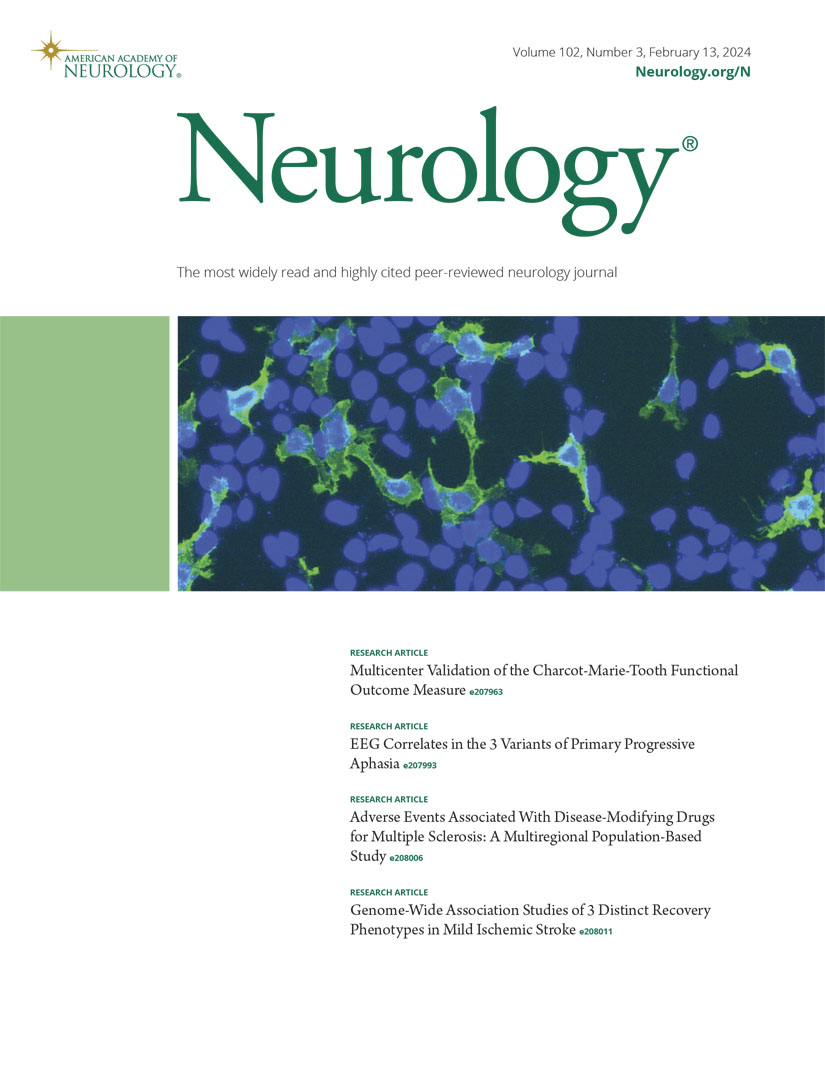Evolution of Cortical Lesions and Function-Specific Cognitive Decline in People With Multiple Sclerosis.
IF 7.7
1区 医学
Q1 CLINICAL NEUROLOGY
引用次数: 0
Abstract
BACKGROUND AND OBJECTIVES Cortical lesions in multiple sclerosis (MS) severely affect cognition, but their longitudinal evolution and impact on specific cognitive functions remain understudied. This study investigates the evolution of function-specific cognitive functioning over 10 years in people with MS and assesses the influence of cortical lesion load and formation on these trajectories. METHODS In this prospectively collected study, people with MS underwent 3T MRI (T1 and fluid-attenuated inversion recovery) at 3 study visits between 2008 and 2022. Cognitive functioning was evaluated based on neuropsychological assessment reflecting 7 cognitive functions: attention; executive functioning (EF); information processing speed (IPS); verbal fluency; and verbal, visuospatial, and working memory. Cortical lesions were manually identified on artificial intelligence-generated double-inversion recovery images. Linear mixed models were constructed to assess the temporal evolution between cortical lesion load and function-specific cognitive decline. In addition, analyses were stratified by MS disease stage: early and late relapsing-remitting MS (cutoff disease duration at 15 years) and progressive MS. RESULTS The study included 223 people with MS (mean age, 47.8 ± 11.1 years; 153 women) and 62 healthy controls. All completed 5-year follow-up, and 37 healthy controls and 94 with MS completed 10-year follow-up. At baseline, people with MS exhibited worse functioning of IPS and working memory. Over 10 years, cognitive decline was most severe in attention, verbal memory, and EF. At baseline, people with MS had a median cortical lesion count of 7 (range 0-73), which was related to subsequent decline in attention (B[95% CI] = -0.22 [-0.40 to -0.03]) and verbal fluency (B[95% CI] = -0.23[-0.37 to -0.09]). Over time, cortical lesions increased by a median count of 4 (range -2 to 71), particularly in late and progressive disease, and was related to decline in verbal fluency (B [95% CI] = -0.33 [-0.51 to -0.15]). The associations between (change in) cortical lesion load and cognitive decline were not modified by MS disease stage. DISCUSSION Cognition worsened over 10 years, particularly affecting attention, verbal memory, and EF, while preexisting impairments were worst in other functions such as IPS. Worse baseline cognitive functioning was related to baseline cortical lesions, whereas baseline cortical lesions and cortical lesion formation were related to cognitive decline in functions less affected at baseline. Accumulating cortical damage leads to spreading of cognitive impairments toward additional functions.多发性硬化症患者皮质病变的演变和功能特异性认知能力下降。
背景与目的多发性硬化症(MS)的皮质病变严重影响认知,但其纵向演变和对特定认知功能的影响仍未得到充分研究。本研究调查了MS患者10年来功能特异性认知功能的演变,并评估了皮质损伤负荷和形成对这些轨迹的影响。方法在这项前瞻性研究中,MS患者在2008年至2022年的3次研究访问中接受了3T MRI (T1和液体衰减反转恢复)。认知功能评估基于反映7项认知功能的神经心理学评估:注意;执行功能(EF);信息处理速度;语言流畅;还有语言,视觉空间和工作记忆。在人工智能生成的双反转恢复图像上手动识别皮质病变。构建线性混合模型来评估皮层损伤负荷与功能特异性认知衰退之间的时间演化。此外,根据MS疾病分期进行分析:早期和晚期复发缓解型MS(疾病持续时间截止为15年)和进展型MS。结果研究纳入223例MS患者(平均年龄47.8±11.1岁;153名妇女)和62名健康对照者。所有患者均完成了5年随访,37名健康对照者和94名多发性硬化症患者完成了10年随访。在基线时,多发性硬化症患者表现出更差的IPS和工作记忆功能。在10年的时间里,注意力、言语记忆和EF的认知能力下降最为严重。在基线时,多发性硬化症患者的中位皮质损伤计数为7(范围0-73),这与随后注意力(B[95% CI] = -0.22[-0.40至-0.03])和语言流畅性(B[95% CI] = -0.23[-0.37至-0.09])的下降有关。随着时间的推移,皮质病变中位数增加4(范围-2至71),特别是在晚期和进展性疾病中,并且与语言流畅性下降有关(B [95% CI] = -0.33[-0.51至-0.15])。皮质损伤负荷(变化)与认知能力下降之间的关联不受MS疾病分期的影响。认知能力在10年内恶化,尤其是影响注意力、言语记忆和EF,而先前存在的损伤在其他功能(如IPS)中最为严重。较差的基线认知功能与基线皮质病变有关,而基线皮质病变和皮层病变形成与基线时较少受影响的认知功能下降有关。累积的皮质损伤导致认知障碍向其他功能扩散。
本文章由计算机程序翻译,如有差异,请以英文原文为准。
求助全文
约1分钟内获得全文
求助全文
来源期刊

Neurology
医学-临床神经学
CiteScore
12.20
自引率
4.00%
发文量
1973
审稿时长
2-3 weeks
期刊介绍:
Neurology, the official journal of the American Academy of Neurology, aspires to be the premier peer-reviewed journal for clinical neurology research. Its mission is to publish exceptional peer-reviewed original research articles, editorials, and reviews to improve patient care, education, clinical research, and professionalism in neurology.
As the leading clinical neurology journal worldwide, Neurology targets physicians specializing in nervous system diseases and conditions. It aims to advance the field by presenting new basic and clinical research that influences neurological practice. The journal is a leading source of cutting-edge, peer-reviewed information for the neurology community worldwide. Editorial content includes Research, Clinical/Scientific Notes, Views, Historical Neurology, NeuroImages, Humanities, Letters, and position papers from the American Academy of Neurology. The online version is considered the definitive version, encompassing all available content.
Neurology is indexed in prestigious databases such as MEDLINE/PubMed, Embase, Scopus, Biological Abstracts®, PsycINFO®, Current Contents®, Web of Science®, CrossRef, and Google Scholar.
 求助内容:
求助内容: 应助结果提醒方式:
应助结果提醒方式:


